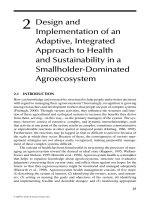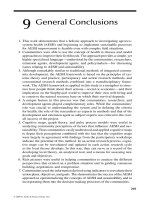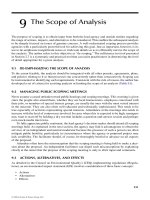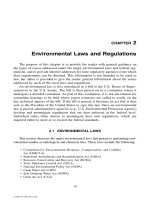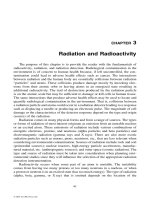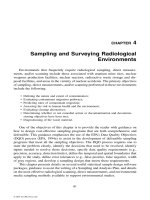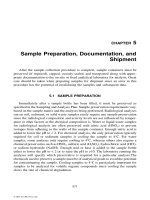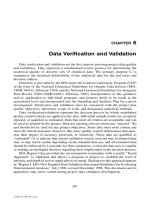SAMPLING AND SURVEYING RADIOLOGICAL ENVIRONMENTS - CHAPTER 9 potx
Bạn đang xem bản rút gọn của tài liệu. Xem và tải ngay bản đầy đủ của tài liệu tại đây (81.99 KB, 6 trang )
311
CHAPTER
9
Equipment Decontamination
When performing environmental investigations, all sampling equipment must be
treated as if it is contaminated, and therefore should be thoroughly decontaminated
between sampling points. Decontamination procedures for radiologically and chem-
ically contaminated equipment are presented in Sections 9.1 and 9.2, respectively.
Decontamination is defined as the process of removing, neutralizing, washing,
and rinsing surfaces of equipment and personal protective clothing to minimize the
potential for contaminant migration. Decontamination is performed to assure the
collection of representative environmental samples. The only way to eliminate
decontamination is by using disposable equipment.
It is critical to test the effectiveness of any decontamination procedure so that
the credibility of environmental samples cannot be questioned. For radiological
contaminants, this is accomplished by scanning the decontaminated equipment and
by collecting swipe samples for radiological counting. If the results from the
scanning measurements and swipe sampling exceed radiological release limits,
additional decontamination steps must be taken to remove the contamination. If the
results are below the release limit, the equipment may be released for use in
collecting additional samples.
For highly radioactive environments, the equipment may not be able to be
decontaminated sufficiently to meet the release limits. Sampling equipment that
cannot meet the release limits should be disposed of. Large equipment (used to
support sampling activities) that cannot meet the release limits may in some instances
still be used as long as it does not come in direct contact with the samples being
collected. In this situation, every effort should be made to reduce the amount of
removable contamination.
For chemical contaminants, testing the effectiveness of the decontamination
procedure is accomplished through the preparation of equipment rinsate blank sam-
ples which are prepared by pouring ASTM Type II reagent-grade (or equivalent)
water over decontaminated sampling equipment, and collecting the rinsate in sample
bottles. The rinsate sample is then shipped to the laboratory and is analyzed for the
same parameters as the environmental sample. If the results from the analysis of
equipment rinsate samples identify contamination, the chemical decontamination
© 2001 by CRC Press LLC
312 SAMPLING AND SURVEYING RADIOLOGICAL ENVIRONMENTS
procedure was proved to be ineffective. In this case, the analytical data for any
samples collected with the contaminated equipment should not be used.
The decontamination of large equipment and sampling equipment should be
performed as close to the study area as possible to prevent the possible spread of
contamination.
9.1 RADIOLOGICAL DECONTAMINATION PROCEDURE
The following four methods are available to support the decontamination of
radiologically contaminated equipment, and are presented in order for increasing
levels of contamination. One should begin with the first decontamination method
that is practical. If the first method used is not effective in removing the contami-
nation, proceed to the next method.
9.1.1 Tape Method
1. Apply masking tape or duct tape to the surface of the equipment.
2. Remove the tape.
3. Repeat Steps 1 and 2 until the entire surface of the equipment has been covered.
4. Scan the surfaces of the equipment for gross alpha and gross beta/gamma activity
to determine if equipment meets radiological release limits.
5. Collect swipe samples from the areas showing the highest activity (based on the
scanning measurements) to determine if equipment meets radiological release
limits for removable gross alpha and gross beta/gamma activity.
6. If radiological release limits have been met, release the equipment for reuse. If
radiological release limits have not been met, proceed to Section 9.1.2 and perform
the next level of decontamination.
7. Document the results from the scanning surveys and the swipe samples.
8. When practical, wrap the equipment in plastic sheeting or aluminum foil to keep
it clean prior to use.
9.1.2 Manual Cleaning Method
1. Remove soil adhering to equipment by scraping, brushing (wire brush), or wiping.
2. Wash thoroughly with a strong nonphosphate detergent/soap wash.
3. Rinse equipment with tap water.
4. Rinse equipment with ASTM Type II (or equivalent) water. Note, this step is only
required when decontaminating sampling equipment.
5. Allow equipment to air dry.
6. Scan the surfaces of the equipment for gross alpha and gross beta/gamma activity
to determine if equipment meets radiological release limits.
7. Collect swipe samples from the areas showing the highest activity (based on the
scanning measurements) to determine if equipment meets radiological release
limits.
8. If radiological release limits have been met, release the equipment for reuse. If
radiological release limits have not been met, proceed to Section 9.1.3.
9. Document the results from the scanning surveys and the swipe samples.
© 2001 by CRC Press LLC
EQUIPMENT DECONTAMINATION 313
10. When practical, wrap the equipment in plastic sheeting or aluminum foil to keep
it clean prior to use.
9.1.3 HEPA Vacuum Method
1. Remove soil adhering to equipment by scraping, brushing (wire brush), or wiping.
2. Use a HEPA Vacuum system to vacuum surfaces of the equipment.
3. Rinse equipment with tap water.
4. Rinse equipment with ASTM Type II (or equivalent) water. Note, this step is only
required when decontaminating sampling equipment.
5. Allow equipment to air dry.
6. Scan the surfaces of the equipment for gross alpha and gross beta/gamma activity
to determine if equipment meets radiological release limits.
7. Collect swipe samples from the areas showing the highest activity (based on the
scanning measurements) to determine if equipment meets radiological release
limits.
8. If radiological release limits have been met, release the equipment for reuse. If
radiological release limits have not been met, proceed to Section 9.1.4.
9. Document the results from the scanning surveys and the swipe samples.
10. When practical, wrap the equipment in plastic sheeting or aluminum foil to keep
it clean prior to use.
9.1.4 High-Pressure Wash Method
1. Remove soil adhering to equipment by scraping, brushing (wire brush), or wiping.
2. Use a pressure washer to steam clean equipment thoroughly with potable water
and a nonphosphatic laboratory-grade detergent. The pressure washer should pro-
duce a minimum water pressure of 80 psi and a minimum temperature of 180˚F.
3. Use a pressure washer to rinse equipment with tap water.
4. Rinse equipment with ASTM Type II (or equivalent) water. Note, this step is only
required when decontaminating sampling equipment.
5. Allow equipment to air dry.
6. Scan the surfaces of the equipment for gross alpha and gross beta/gamma activity
to determine if equipment meets radiological release limits.
7. Collect swipe samples from the areas showing the highest activity (based on the
scanning measurements) to determine if equipment meets radiological release
limits.
8. If radiological release limits have been met, release the equipment for reuse. If
radiological release limits have not been met for sampling equipment, dispose of
equipment. If radiological release limits have not been met for large equipment, it
may be considered for reuse only if does not come in direct contact with the
samples being collected.
9. Document the results from the scanning surveys and the swipe samples.
10. When practical, wrap the equipment in plastic sheeting or aluminum foil to keep
it clean prior to use.
© 2001 by CRC Press LLC
314 SAMPLING AND SURVEYING RADIOLOGICAL ENVIRONMENTS
9.2 CHEMICAL DECONTAMINATION PROCEDURE
9.2.1 Large Equipment
The following method should be used to decontaminate all types of large equip-
ment used to support chemical sampling activities (e.g., drilling augers, drill bit, A-
rod).
1. Remove soil adhering to equipment by scraping, brushing (wire brush), or wiping.
2. Use a pressure washer to steam clean equipment thoroughly with potable water
and a nonphosphatic laboratory-grade detergent. The pressure washer should pro-
duce a minimum water pressure of 80 psi and a minimum temperature of 180˚F.
3. Use a pressure washer to rinse equipment with tap water.
4. Allow equipment to air dry.
5. When practical, wrap the equipment in plastic sheeting or aluminum foil to keep
it clean prior to use.
9.2.2 Sampling Equipment
The following methods should be used to decontaminate all types of equipment
used to perform chemical sampling activities. This equipment includes but is not
limited to:
• Deep soil sampling equipment (e.g., split-spoon, thin-walled tube samplers)
• Shallow soil sampling equipment (e.g., hand augers, core sampler)
• Sediment sampling equipment (e.g., box sampler, core sampler)
• Surface water/groundwater sampling equipment (e.g., dipper, bailer, bladder pump)
• Concrete/asphalt sampling equipment (e.g., core barrel)
• Paint sampling equipment (e.g., spatula)
• Air sampling equipment
• Support equipment coming in contact with sample (e.g., discharge lines, bowls,
spoons)
When samples are to be analyzed for inorganics, a dilute hydrochloric or nitric
acid solution rinse must be used in the decontamination procedure. Dilute hydro-
chloric acid is generally preferred over nitric acid when cleaning stainless steel
because nitric acid may oxidize this material.
When samples are to be analyzed for organic contaminants, the equipment
decontamination procedure should include a rinse with pesticide-grade acetone and
hexane, in that order. Pesticide-grade methanol may be used instead of acetone.
When samples are to be analyzed for both inorganics and organics, a dilute hydro-
chloric or nitric acid solution rinse must be used in combination with a pesticide-
grade acetone and hexane rinse.
Below are three equipment decontamination procedures. The first procedure
should be used when samples are to be analyzed for inorganic parameters only. The
second procedure should be used when samples are to be analyzed for organic
© 2001 by CRC Press LLC
EQUIPMENT DECONTAMINATION 315
parameters only, and the third should be used if samples are to be analyzed for both
organic and inorganic parameters.
Inorganic Procedure
1. Remove soil adhering to equipment by scraping, brushing (wire brush), or
wiping.
2. Wash thoroughly with a strong nonphosphate detergent/soap wash.
3. Rinse thoroughly with tap water.
4. Rinse with ASTM Type II (or equivalent) water.
5. Rinse with dilute hydrochloric or nitric acid solution.
6. Rinse with ASTM Type II (or equivalent) water.
7. Allow equipment to air dry.
8. Wrap equipment in aluminum foil (shiny side out) to keep it clean prior to use.
Organic Procedure
1. Remove soil adhering to equipment by scraping, brushing (wire brush), or
wiping.
2. Wash thoroughly with a strong nonphosphate detergent/soap wash.
3. Rinse thoroughly with tap water.
4. Rinse with ASTM Type II (or equivalent) water.
5. Rinse with pesticide-grade acetone (or methanol).
6. Rinse with pesticide-grade hexane.
7. Allow equipment to air dry.
8. Wrap equipment in aluminum foil (shiny side out) to keep it clean prior to use.
Combined Inorganic/Organic Procedure
1. Remove soil adhering to equipment by scraping, brushing (wire brush), or
wiping.
2. Wash thoroughly with a strong nonphosphate detergent/soap wash.
3. Rinse thoroughly with tap water.
4. Rinse with ASTM Type II (or equivalent) water.
5. Rinse with dilute hydrochloric or nitric acid solution.
6. Rinse with ASTM Type II (or equivalent) water.
7. Rinse with pesticide-grade acetone (or methanol).
8. Rinse with pesticide-grade hexane.
9. Allow equipment to air dry.
10. Wrap equipment in aluminum foil (shiny side out) to keep it clean prior to use.
The dilute acid solution, acetone, hexane, and distilled/deionized water are most
easily handled when they are contained within Teflon squirt bottles. Squirt bottles
made of substances other than Teflon should not be used, since they have the potential
to contaminate the solutions. When using these solutions, the drippings should be
caught in a bucket or tub. The acetone and hexane drippings should be allowed to
volatilize into the air, while the acid solution drippings should be neutralized using
baking soda.
Decontaminating pumps is more difficult than other sampling equipment since
many of them are not easy to disassemble. The procedure to use for these tools is
to place the pump in a large decontamination tub full of nonphosphate detergent
© 2001 by CRC Press LLC
316 SAMPLING AND SURVEYING RADIOLOGICAL ENVIRONMENTS
and tap water. The pump is turned on, which forces the wash water through the
pump and discharge line. The same procedure is repeated in a tub full of clean tap
water. The outside of the pump and outside of the pressure and discharge lines are
then decontaminated using the sampling decontamination methods described above.
All of the water generated from this decontamination procedure must be con-
tainerized and then analytically tested to determine the appropriate method for
disposal. Discharge permits must be acquired from the city and/or county prior to
discharging decontamination water into any sanitary or storm sewer system.
REFERENCES
EPA (Environmental Protection Agency), A Compendium of Superfund Field Operations
Methods, EPA/540/P-87/001a, 1987.
EPA (Environmental Protection Agency), RCRA Facility Investigation (RFI) Guidance, PB89-
200299, 1989.
© 2001 by CRC Press LLC
